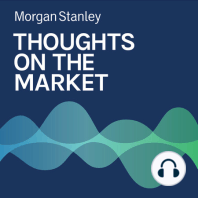3 min listen

Vishy Tirupattur: Corporate Credit - Calm Amidst the Storm
Vishy Tirupattur: Corporate Credit - Calm Amidst the Storm
ratings:
Length:
4 minutes
Released:
Oct 29, 2021
Format:
Podcast episode
Description
Investors have had a lot to take in over the past few weeks, but corporate credit markets remain calm despite turbulence elsewhere. Vishy Tirupattur explains. ----- Transcript -----Welcome to Thoughts on the Market. I am Vishy Tirupattur, Global Director of Fixed Income Research. Along with my colleagues, bringing you a variety of perspectives, I'll be talking about the current calm in the corporate credit markets. It's Friday, October 29th at 1:00 p.m. in New York.Over the past few weeks, risk markets have been buffeted by volatility from a wide array of sources. It was around a month ago that the regulatory reset in China and the near-term funding pressures on select property developers roiled global markets, as investors fretted all the systemic implications for global growth.Then, a mixed U.S. jobs report, along with sharply higher commodity prices, intensified the debate around stagflation. And the rhetoric from multiple central banks has been increasingly hawkish. So, a lot for investors to take in.The combination of these concerns has resulted in substantial market gyrations. The S&P 500 index declined by about 4% before recovering to all-time highs. The shape of the Treasury yield curve has twisted and turned. The benchmark 10-year Treasury interest rate went from around 1.3% to around 1.7% and back down to 1.56%. The market pricing of the timing of a Fed rate hike has come in sharply.But amidst all these substantial moves, corporate credit markets on both sides of the Atlantic have largely stayed calm. Credit spreads, which are the risk premium investors demand to hold corporate debt or U.S. treasuries, have hovered near 52-week tights in investment grade, high yield and leveraged loans across the U.S. and Europe. And with surprisingly limited volatility.Credit market volatility relative to equity markets remains very low. Market access for companies across the credit spectrum has remained robust, as indicated by strong issuance trends, running at or ahead of the pace of a year ago. So, what explains this stark difference between credit and other markets? The answer boils down to meaningfully improved credit fundamentals and elevated company balance sheet liquidity, leading to a decidedly benign outlook for defaults over the next 12 months, if not longer.Morgan Stanley's credit strategists Srikanth Sankaran and Vishwas Patkar have highlighted that the balance sheet damage from COVID has been reversed. At the end of the second quarter this year, gross leverage in U.S. investment grade credit has declined sharply back to pre-COVID levels. Net leverage is now below pre-COVID levels, while interest coverage has risen sharply to a seven-year high. The trends in the high yield sector are even more impressive, driven not just by the rebound in earnings but also negative debt growth. After four consecutive quarters of declines from the second quarter 2020 peak, median leverage now sits below the pre-COVID trough. That 71% of the issuers are now reporting lower growth levels quarter over quarter, reflects the broad-based improvement we are seeing in the market.Even in the leveraged buyout world, while 2021 has been a bumper year for acquisition activity, unprecedented equity cushions have resulted in a much better alignment of sponsor and lender interests, helping to alleviate concerns.So, what are the implications for investors? A lot, of course, is already in the price. With credit spreads near the tight end of the spectrum, we are more likely to see them widen than tighten. Indeed, the base case expectation of our credit strategists is more modestly wider splits. However, the strength in credit fundamentals suggests that the outlook for defaults is benign, and likely below long term average default levels. Thus, we prefer taking default risk to spread risk here, leading us to favor high yield credit or investment grade credit and, within high yield, loans over bonds.Thanks for listening. If you enjoy the show, please leave
Released:
Oct 29, 2021
Format:
Podcast episode
Titles in the series (100)
Andrew Sheets: For Markets, Signs, Signs, Everywhere Signs by Thoughts on the Market